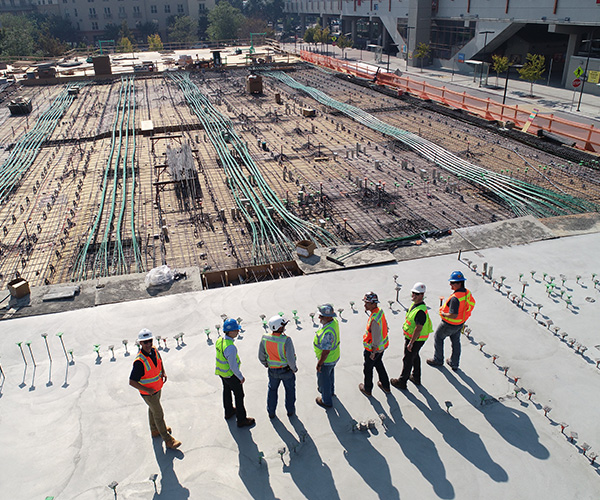Cultivating Harmony: Strategies for Managing Cultural Fit in Construction Teams
WEBUILD STAFFING BLOG |
Cultivating Harmony: Strategies for Managing Cultural Fit in Construction Teams

In the construction industry, the importance of cultural fit within teams cannot be overstated. A cohesive and harmonious team culture fosters trust, communication, and productivity, leading to successful project outcomes. However, managing cultural fit in construction teams can be challenging due to the diverse backgrounds, personalities, and work styles of team members.
Understanding Cultural Fit in Construction Teams:
Cultural fit typically refers to the alignment of values, attitudes, and behaviors between individual team members and the broader organizational culture. In construction teams, cultural fit influences how team members interact, communicate, and collaborate with one another, as well as their overall effectiveness and satisfaction in their roles. A strong cultural fit fosters a sense of belonging, camaraderie, and shared purpose within teams, enhancing morale, engagement, and performance.
Challenges of Managing Cultural Fit in Construction Teams:
Managing cultural fit in construction teams presents several challenges, including:
- Diversity of Backgrounds and Perspectives: Construction teams often comprise individuals with diverse backgrounds, experiences, and perspectives, which can lead to differences in communication styles, work preferences, and problem-solving approaches.
- High Turnover and Temporary Assignments: Construction projects typically involve temporary teams assembled for specific projects, leading to frequent turnover and changes in team composition. Managing cultural fit becomes more challenging when team members come and go throughout the project lifecycle.
- Hierarchy and Power Dynamics: Construction projects often involve hierarchical structures and power dynamics, with project managers, subcontractors, and laborers occupying different roles and responsibilities. Navigating these dynamics while fostering a collaborative team culture requires effective communication and leadership.
Strategies for Ensuring Harmony in Construction Teams:
Despite the challenges, there are several strategies that construction project managers and team leaders can employ to manage cultural fit and promote harmony within teams:
Define Core Values and Behaviors:
Establishing clear core values and expected behaviors can provide a framework for promoting cultural fit within construction teams. Project managers should communicate these values and behaviors to team members and lead by example to reinforce their importance. Examples of core values may include integrity, accountability, collaboration, and safety.
Prioritize Communication and Transparency:
Open and transparent communication is essential for fostering trust, collaboration, and alignment within construction teams. Project managers should create opportunities for regular team meetings, one-on-one discussions, and feedback sessions to address issues, share updates, and solicit input from team members. Clear communication channels and protocols should be established to ensure that information flows freely throughout the team.
Encourage Diversity and Inclusion:
Embracing diversity and inclusion within construction teams can enrich perspectives, foster innovation, and enhance problem-solving capabilities. Project managers should actively seek out diverse talent and create an inclusive work environment where all team members feel valued, respected, and empowered to contribute their unique skills and perspectives.
Facilitate Team Building Activities:
Team building activities can help strengthen relationships, build trust, and improve collaboration within construction teams. Project managers should organize team-building exercises, social events, and off-site retreats to promote camaraderie and create opportunities for team members to get to know each other on a personal level.
Provide Training and Development Opportunities:
Investing in training and development opportunities can help bridge skill gaps, enhance competencies, and promote a shared understanding of roles and responsibilities within construction teams. Project managers should offer training programs, workshops, and certifications to equip team members with the knowledge and skills needed to excel in their roles.
Lead by Example:
Effective leadership is essential for shaping team culture and promoting cultural fit within construction teams. Project managers should lead by example, demonstrating the values, behaviors, and work ethic they expect from team members. By modeling professionalism, integrity, and collaboration, project managers can inspire trust, respect, and loyalty among team members.
Address Conflict Promptly and Constructively:
Conflict is inevitable in any team environment, but how it is managed can make a significant difference in maintaining harmony within construction teams. Project managers should address conflicts promptly and constructively, facilitating open dialogue, active listening, and problem-solving to resolve issues and restore harmony. Mediation or conflict resolution techniques may be employed to facilitate productive discussions and reach mutually satisfactory outcomes.
Real World Cultural Fit Case Studies:
Several real-life case studies illustrate the successful implementation of strategies for managing cultural fit in construction teams:
Northstar Construction:
Northstar Construction, a mid-sized commercial contractor, implemented a cultural fit assessment during the hiring process to ensure alignment with the company’s core values and team dynamics. Candidates undergo behavioral interviews and personality assessments to evaluate their compatibility with the company culture. As a result, Northstar Construction has built a cohesive and high-performing team that shares a strong sense of purpose and camaraderie.
ZYPTER Engineering:
ZYPTER Engineering, a structural engineering firm, fosters cultural fit within its teams by organizing regular team-building activities and social events. Team members participate in quarterly team outings, volunteer projects, and sports leagues to strengthen relationships and build trust. These activities have contributed to a positive team culture characterized by collaboration, mutual support, and shared success.
In conclusion, managing cultural fit is essential for promoting harmony, cohesion, and productivity within construction teams. By defining these core competencies and working toward building a cohesive team will benefit the long-term success of the organization and employee satisfaction.
We build Staffing Agency is a leading executive search and staffing agency dedicated to the construction, engineering and environmental industries. To learn more please visit: www.webuildstaffing.com










